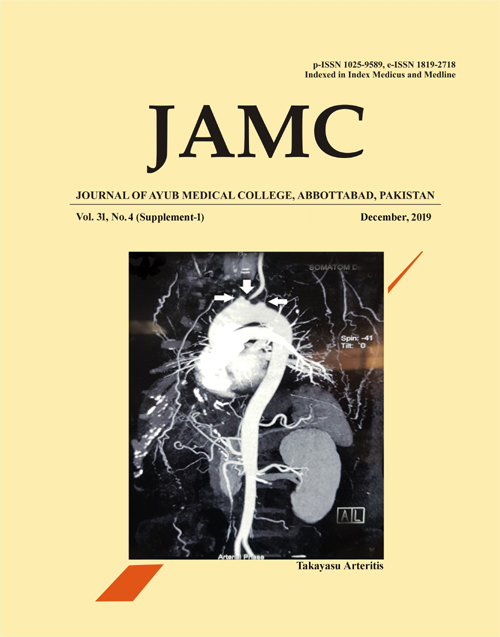EFFECTS OF CARDIOVASCULAR CONDITIONING EXERCISES ON QUALITY OF LIFE IN PATIENTS WITH DILATED CARDIOMYOPATHY IN PAKISTAN
Abstract
Background: Dilated Cardiomyopathy (DCM) is the most frequently diagnosed cardiomyopathy in Pakistan and patients have significant muscles dysfunction which affects their quality of life (QOL). Available evidence have supported the role of moderate intensity exercise for improving QOL but no such studies have been conducted in Pakistan so far. Methods: A single blinded randomized controlled trial was conducted in two different hospitals of Rawalpindi from September 2016-February 2017. Both genders clinically stable DCM patients with ejection fraction <40% were selected through purposive non-probability sampling and randomized to Training group and Control group (n=30 each). Training group protocol included bicycling on lower limb ergometer 4days/week on alternate days for 8 weeks. Patients in control group received usual care. Patients were assessed thrice during 8-week protocol. The tools used included structured questionnaire with different standard scales like 6 Minute Walk Test, Modified Medical Research Council Scale, Modified Borg Scale and Minnesota Living with Heart Failure Questionnaire. Data was analysed on SPSS 21 software. Results: Prior to conditioning in training group, 6 (21%) patients reported good and 23 (79%) have poor QOL whereas in control group 14 (56%) have good and 11 (44%) have poor QOL on MLHFQ score. After 8 weeks in training group, 28 (96%) patients reported excellent QOL and in control group, 11 (44%) reported good and 14(56%) have poor QOL on MLHFQ score. Between the groups analysis depicted highly significant p values for QOL and New York Heart Association (NYHA) class (p<0.001). Conclusion: Supervised cardiac conditioning program significantly improves Quality of life and NYHA functional class in dilated cardiomyopathy.
Keywords: Cardiac rehabilitation; Dilated cardiomyopathy; Exercise; Minnesota Living with Heart Failure; Quality of life; NYHAReferences
Siyal FJ, Dayo A, Sial JA, Ghoto MA, Malik A, Memon N, et al. Prescription trend of challenging problems in cardiac patients of Larkana Pakistan. Int J Pharm Sci Rev Res 2014;24(1):263-7.
Paul R, Nandi S, Sinha PK. Epidemiological study of dilated cardiomyopathy from eastern india with special reference to left atrial size. Int J Med Res Health Sci 2014;3(3):639-44.
Ilyas S, Fawad A, Ilyas H, Hameed A, Awan ZA, Zehra A, et al. Echomorphology of cardiomyopathy: review of 217 cases from 1999 to 2010. J Pak Med Assoc 2013;63(4):454-8.
Klempfner R, Kamerman T, Schwammenthal E, Nahshon A, Hay I, Goldenberg I, et al. Efficacy of exercise training in symptomatic patients with hypertrophic cardiomyopathy: results of a structured exercise training program in a cardiac rehabilitation center. Eur J Prev Cardiol 2015;22(1):13-9.
American Heart Association. Dilated Cardimyopathy. [Internet]. [cited 2017 Jan 24]. Available from: http://www.strokeassociation.org/idc/groups/heart-public/@wcm/@hcm/documents/downloadable/ucm_312224.pdf
Holloway CJ, Dass S, Suttie JJ, Rider OJ, Cox P, Cochlin LE, et al. Exercise training in dilated cardiomyopathy improves rest and stress cardiac function without changes in cardiac high energy phosphate metabolism. Heart 2012;98(14):1083-90.
Quittan M, Sturm B, Wiesinger GF, Pacher R, Fialka-Moser V. Quality of life in patients with chronic heart failure: a randomized controlled trial of changes induced by a regular exercise program. Scand J Rehabil Med 1999;31(4):223-8.
La Gerche A, Heidbuchel H. Can Intensive Exercise Harm the Heart?: You Can Get Too Much of a Good Thing. Circulation 2014;130(12):992-1002.
Stolen KQ, Kemppainen J, Ukkonen H, Kalliokoski KK, Luotolahti M, Lehikoinen P, et al. Exercise training improves biventricular oxidative metabolism and left ventricular efficiency in patients with dilated cardiomyopathy. J Am Coll Cardiol 2003;41(3):460-7.
Chrysohoou C, Tsitsinakis G, Vogiatzis I, Cherouveim E, Antoniou C, Tsiantilas A, et al. High intensity, interval exercise improves quality of life of patients with chronic heart failure: a randomized controlled trial. QJM 2013;107(1):25-32.
Willenheimer R, Erhardt L, Cline C, Rydberg E, Israelsson B. Exercise training in heart failure improves quality of life and exercise capacity. Eur Heart J 1998;19(5):774-81.
Savage PA, Shaw AO, Miller MS, VanBuren P, LeWinter MM, Ades PA, et al. Effect of resistance training on physical disability in chronic heart failure. Med Sci Sports Exerc 2011;43(8):1379-86.
Downloads
Published
How to Cite
Issue
Section
License
Journal of Ayub Medical College, Abbottabad is an OPEN ACCESS JOURNAL which means that all content is FREELY available without charge to all users whether registered with the journal or not. The work published by J Ayub Med Coll Abbottabad is licensed and distributed under the creative commons License CC BY ND Attribution-NoDerivs. Material printed in this journal is OPEN to access, and are FREE for use in academic and research work with proper citation. J Ayub Med Coll Abbottabad accepts only original material for publication with the understanding that except for abstracts, no part of the data has been published or will be submitted for publication elsewhere before appearing in J Ayub Med Coll Abbottabad. The Editorial Board of J Ayub Med Coll Abbottabad makes every effort to ensure the accuracy and authenticity of material printed in J Ayub Med Coll Abbottabad. However, conclusions and statements expressed are views of the authors and do not reflect the opinion/policy of J Ayub Med Coll Abbottabad or the Editorial Board.
USERS are allowed to read, download, copy, distribute, print, search, or link to the full texts of the articles, or use them for any other lawful purpose, without asking prior permission from the publisher or the author. This is in accordance with the BOAI definition of open access.
AUTHORS retain the rights of free downloading/unlimited e-print of full text and sharing/disseminating the article without any restriction, by any means including twitter, scholarly collaboration networks such as ResearchGate, Academia.eu, and social media sites such as Twitter, LinkedIn, Google Scholar and any other professional or academic networking site.










